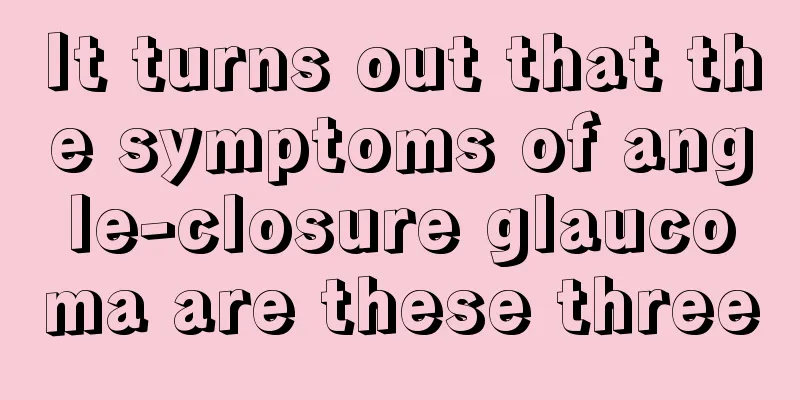It turns out that the symptoms of angle-closure glaucoma are these three

|
Angle-closure glaucoma is a common type of glaucoma in life, which is very harmful to people's eye health. Therefore, it is particularly important to understand the symptoms of angle-closure glaucoma and treat it in time. In fact, the symptoms of angle-closure glaucoma vary depending on the stage of the disease. In the early stage of the disease, one eye has developed acute angle-closure glaucoma, while the other eye has a shallow anterior chamber and a narrow angle, but normal intraocular pressure and no subjective symptoms. 1. Early stage of angle-closure glaucoma: One eye has developed acute angle-closure glaucoma, and the other eye has a shallow anterior chamber and a narrow angle, but normal intraocular pressure and no subjective symptoms. It is in the preclinical stage. 2. Prodromal period of angle-closure glaucoma: Before an acute attack, patients often experience mild headaches, eye swelling, nausea, blurred vision, and temporary iridescence due to emotional fluctuations, mental or physical fatigue, reading for too long, or watching TV or movies. These symptoms will resolve on their own after rest, which is called the prodromal period. Such minor attacks became more and more frequent, and finally turned into an acute major attack. 3. Acute attack of angle-closure glaucoma (1) Because of the sudden increase in intraocular pressure, the patient suddenly feels severe eye pain and headache. Significant decrease in visual acuity, only the anterior index, light perception or no light perception. Due to the vagus nerve reflex, it may be accompanied by nausea and vomiting, and may be easily misdiagnosed as acute gastroenteritis or intracranial disease. A detailed medical history and examination should be conducted to identify the disease. (2) Mixed congestion is obvious, accompanied by congestion and dilation of the conjunctival surface blood vessels, and sometimes mild eyelid and conjunctival edema. (3) Corneal edema, foggy and turbid appearance, sometimes blisters form on the epithelium, sensation is reduced or absent, and there may be pigmentation behind the cornea. (4) The anterior chamber is very shallow and the anterior chamber angle is occluded. Cytochrome particles can be seen floating in the aqueous humor, and even fibrinous exudates. (5) The pupil is dilated, elliptical in shape, and no longer responds to light. This is due to paralysis of the nerve that controls the pupillary dilator muscle. Because of the edema of the refractive media, the pupil takes on a bluish-green color, hence the name glaucoma or glaucoma. The above are the symptoms of angle-closure glaucoma. Do you understand? If you accidentally experience the above symptoms, you must seek treatment in time to avoid serious consequences. |
<<: There are white spots on my arms, what's going on?
Recommend
Is there any effect after applying water light?
In recent years, the cosmetic surgery industry ha...
Left shoulder pain for half a year before being diagnosed with bone cancer
Li Chao, a 12-year-old boy, had been suffering fr...
Supplementing trace elements can prevent nasopharyngeal cancer
The incidence of nasopharyngeal carcinoma is rela...
Oven barbecue recipes
I believe most people prefer to eat barbecue, and...
My teeth hurt when I eat sweets
Some people will feel toothache after eating swee...
How to take care of hangnails on fingers
If you have hangnails on your hands, do not tear ...
Can I lose weight by replacing dinner with fruit
Dinner is a must, and there is nothing wrong with...
Sinusitis inflammation enters the ear
Everyone knows that sinusitis is one of the more ...
Why does my right cheek hurt?
The human cheek is the part of the body that is m...
What is the effective treatment for high creatinine
Creatinine is a product of muscle metabolism in t...
What's the use of expired lipstick
Lipstick should be a must-have cosmetic item in e...
Symptoms of hormones on the face
In our lives, many people have very sensitive ski...
How to treat thrombophlebitis?
Thrombophlebitis is a type of venous vascular dis...
What is the reason for acne on the chin? If you love beauty, you must know
Acne on the chin is a very common condition in li...
What is the difference between vitamin D3 and cod liver oil?
In daily life, vitamin D3 and cod liver oil are b...









